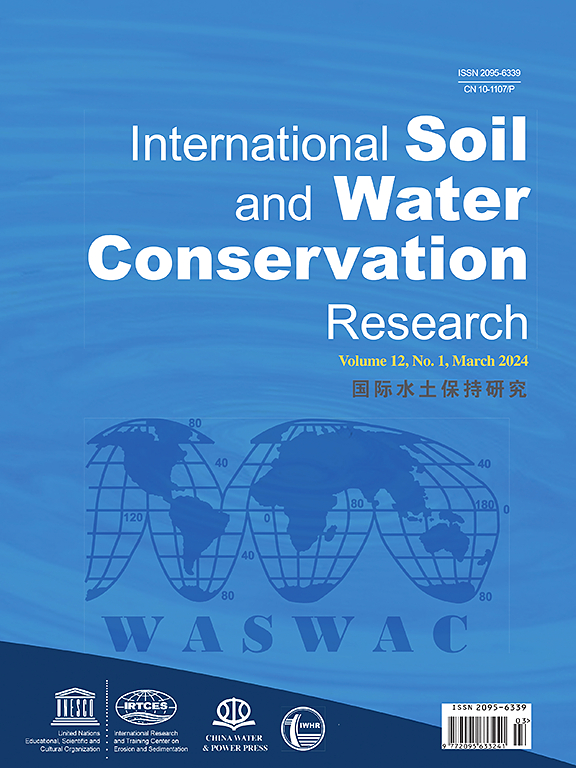National variability in soil organic carbon stock predictions: Impact of bulk density pedotransfer functions
IF 7.3
1区 农林科学
Q1 ENVIRONMENTAL SCIENCES
International Soil and Water Conservation Research
Pub Date : 2024-05-03
DOI:10.1016/j.iswcr.2024.04.002
引用次数: 0
Abstract
Accurate soil organic carbon storage (SOCS) estimation is crucial for sustaining ecosystem health and mitigating climate change impacts. This study investigated the accuracy and variability of SOCS predictions, focusing on the role of pedotransfer functions (PTFs) in estimating soil bulk density (BD). Utilizing a comprehensive dataset from the Korean Rural Development Administration (RDA database), which includes 516 soil horizons, we evaluated 36 widely-used BD PTFs, well-established formulas that estimate BD by considering soil properties, including soil organic carbon (SOC), soil organic matter (OM), sand, gravel, silt, and clay. These PTFs demonstrated varying levels of precision, with root mean squared errors (RMSE) ranging from 0.177 to 0.377 Mg m−3 and coefficients of determination (R2) from 0.176 to 0.658; hence, the PTFs have been classified into excellent, moderate, and poor-performing groups for predicting BD. Further, a novel PTF based on an exponential function of SOC was developed, showing superior predictive power (R2 = 0.73) compared to existing PTFs, using an independent validation dataset. Our findings reveal significant differences in SOCS predictions and observations among the PTFs, with a p-value <0.05. The highest concentrations of SOCS were noted in forest soils, considerably above the national average, highlighting the importance of tailored soil management practices to enhance carbon sequestration. These findings are crucial for refining PTF precision to improve the accuracy of national SOCS estimates, supporting effective land management and climate change mitigation strategies.
土壤有机碳储量预测的全国差异:体积密度 Pedotransfer 函数的影响
准确估算土壤有机碳储量(SOCS)对于维持生态系统健康和减轻气候变化影响至关重要。本研究调查了土壤有机碳储量预测的准确性和可变性,重点关注 pedotransfer 函数(PTF)在估算土壤容重(BD)中的作用。利用韩国农村发展局(RDA 数据库)包含 516 个土壤层的综合数据集,我们评估了 36 个广泛使用的容重 PTF,这些成熟的公式通过考虑土壤特性(包括土壤有机碳 (SOC)、土壤有机质 (OM)、砂、砾石、粉土和粘土)来估算容重。这些 PTF 的精确度各不相同,均方根误差 (RMSE) 从 0.177 到 0.377 Mg m-3 不等,判定系数 (R2) 从 0.176 到 0.658 不等;因此,这些 PTF 在预测 BD 方面的表现被分为优、中、差三类。此外,我们还开发了一种基于 SOC 指数函数的新型 PTF,与现有的 PTF 相比,该 PTF 在使用独立验证数据集时显示出更高的预测能力(R2 = 0.73)。我们的研究结果表明,SOCS 的预测结果与 PTF 之间的观测结果存在明显差异,P 值为 0.05。森林土壤中的 SOCS 浓度最高,大大高于全国平均水平,这凸显了有针对性的土壤管理措施对提高碳固存的重要性。这些发现对于改进 PTF 精确度以提高国家 SOCS 估算的准确性、支持有效的土地管理和气候变化减缓战略至关重要。
本文章由计算机程序翻译,如有差异,请以英文原文为准。
求助全文
约1分钟内获得全文
求助全文
来源期刊

International Soil and Water Conservation Research
Agricultural and Biological Sciences-Agronomy and Crop Science
CiteScore
12.00
自引率
3.10%
发文量
171
审稿时长
49 days
期刊介绍:
The International Soil and Water Conservation Research (ISWCR), the official journal of World Association of Soil and Water Conservation (WASWAC) http://www.waswac.org, is a multidisciplinary journal of soil and water conservation research, practice, policy, and perspectives. It aims to disseminate new knowledge and promote the practice of soil and water conservation.
The scope of International Soil and Water Conservation Research includes research, strategies, and technologies for prediction, prevention, and protection of soil and water resources. It deals with identification, characterization, and modeling; dynamic monitoring and evaluation; assessment and management of conservation practice and creation and implementation of quality standards.
Examples of appropriate topical areas include (but are not limited to):
• Conservation models, tools, and technologies
• Conservation agricultural
• Soil health resources, indicators, assessment, and management
• Land degradation
• Sustainable development
• Soil erosion and its control
• Soil erosion processes
• Water resources assessment and management
• Watershed management
• Soil erosion models
• Literature review on topics related soil and water conservation research
 求助内容:
求助内容: 应助结果提醒方式:
应助结果提醒方式:


